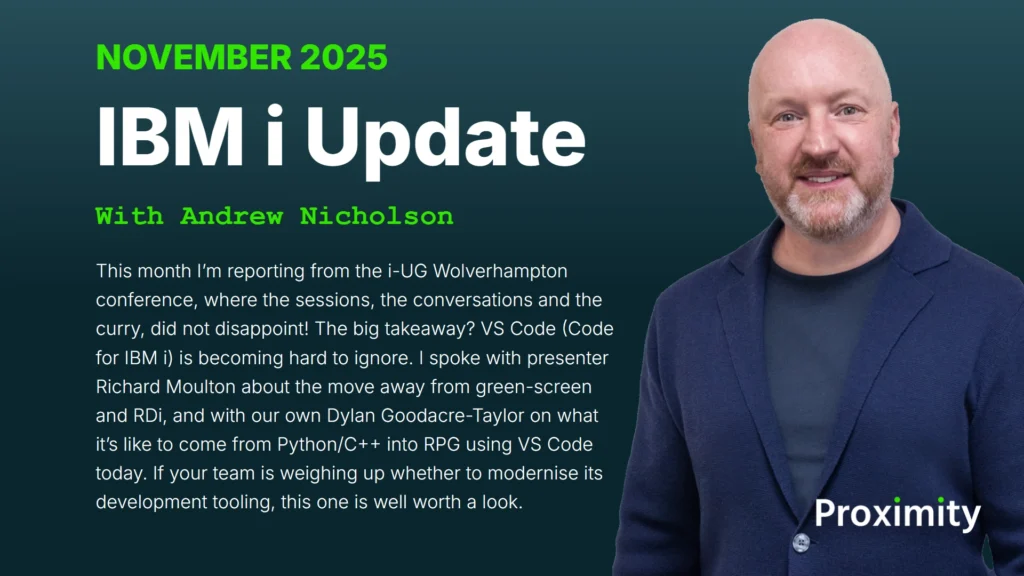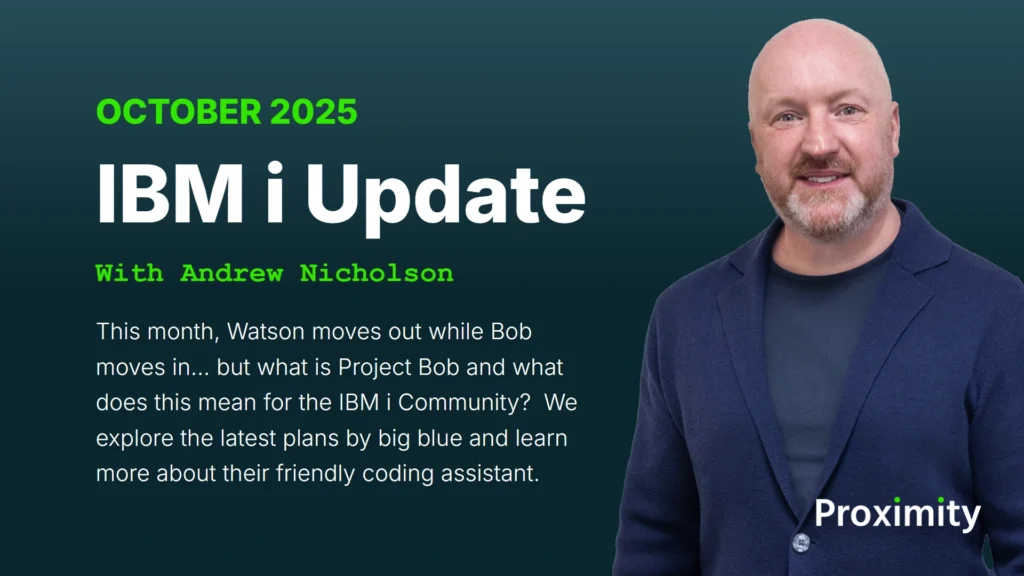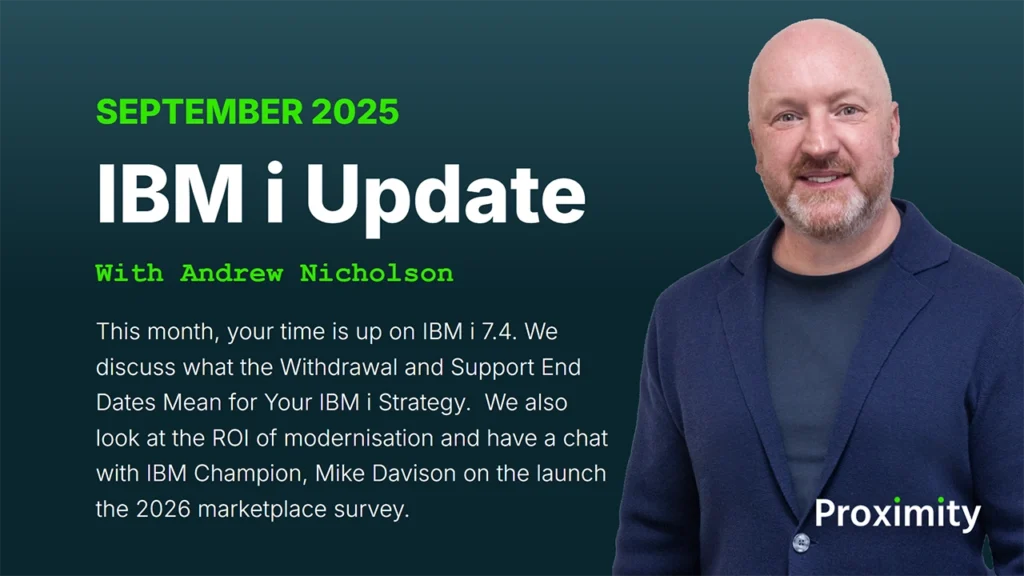In January 2025, Fortra released the results from their latest IBM i Marketplace survey.
This year’s survey is the 11th that Fortra has released. Each one offers a comprehensive and valuable insight into the state of the IBM i ecosystem year-by-year.
Andy Nicholson has covered previous releases in his IBM i Update (which you can subscribe to on LinkedIn).
He gave an indepth summary of this year’s results in the January IBM i Update.
Andy caught up with Mike Davison to discuss the survey results.
Mike is one of Fortra’s Product Managers and is the EMEA Power Systems Support Team Lead.
He’s also a current IBM Champion.
If you’d like to watch the full interview, you can access it on YouTube here or simply press play:
Read the transcript below
Andy Nicholson: Let’s jump straight into it. What do you see as the most significant takeaway from this year’s IBM i marketplace survey?
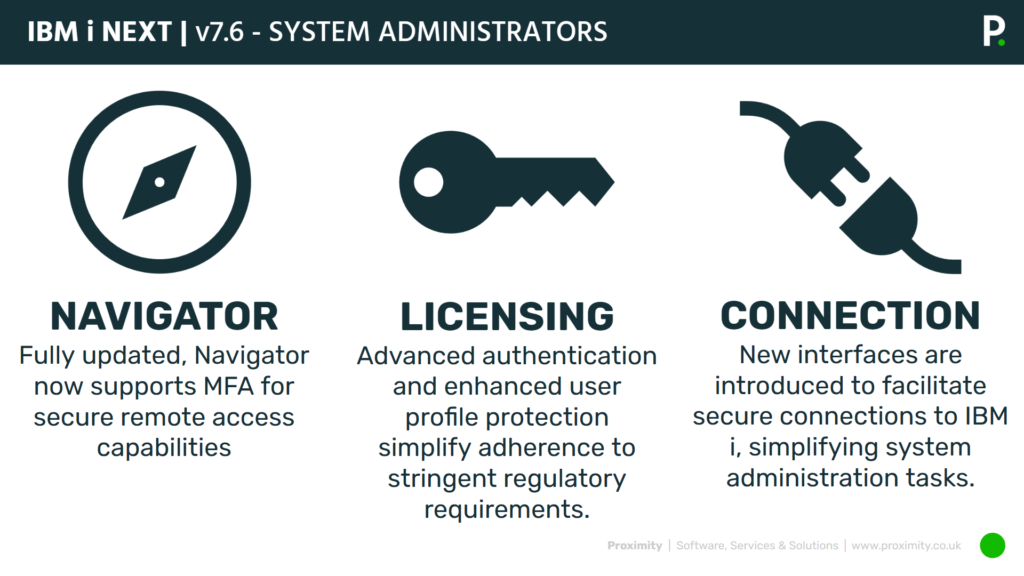
Michael Davison: Astoundingly there is a record high of 96% satisfaction in the platform. So, that message is getting across that the IBM i is reliable, scalable and is the platform that gives a great ROI for customers.
Also cyber security and the IBM i skills issues have been consistently at the top for the last five years and I think they’re the main concerns for customers.
Andy Nicholson: Quite right. But were there any surprises?
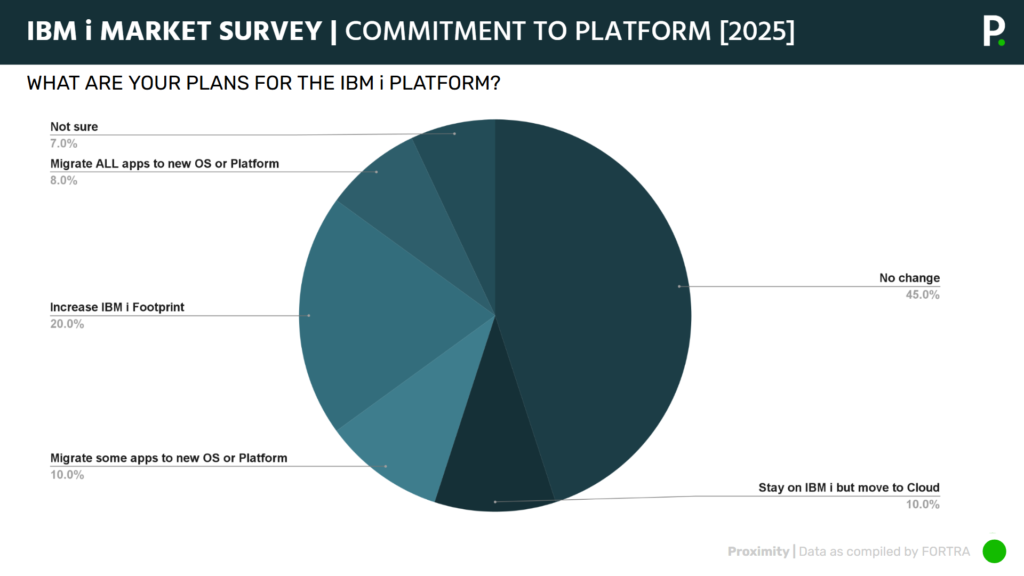
Michael Davison: Not really any surprise of sort but in line with the findings of the report in that there is a 96% satisfaction with the platform and the percentage of those planning to increase their IBM i footprint has jumped from 12 to 20%, an 8% increase from the previous year.
Andy Nicholson: Yet there are still misconceptions about its relevance. Do you think perceptions of the IBMI are changing? And if so, how?
Michael Davison: I’ve been hearing for decades that people were going to move off this platform because it’s old and it’s outdated. And I consistently hear that message today that it’s an old platform especially from CIOs who are wanting to move off it because they don’t understand it.
I do believe that message is starting to get through that the IBM i remains relevant. It’s reliable, scalable, modern and consistently gets better with each iteration from 8 to 9 to 10 to next… We’re seeing it outperforming Windows and Linux on x86based processors. So, I do believe I’m seeing a change in that the message is getting through.
Andy Nicholson: I agree, It’s a modern platform. These misconceptions need to change…
Michael Davison: Yes people see the old green on black and say, “well, that’s old.” But no, let’s have a look at some of the modern GUIs and web pages that are running on IBM i.
Andy Nicholson: Absolutely. And you can marry the two together, have the best of both. Wonderful, beautiful GUIs with that wonderful transactional, safe platform in the background.
Michael Davison: Absolutely. Modernisation, that’s the key.
Andy Nicholson: Security, it’s always been consistently a top concern for IBM i users. Have you noticed any shifts in how companies are addressing security challenges compared to previous years?
Michael Davison: Malware and ransomware have consistently been a huge concern, especially in the last five years.
I’ve noticed most companies as a matter of compliance are inevitably deploying software to protect things like exit points on the IBM i and antivirus to prevent the inevitable ransomware attacks because it’s not a case of ‘if’ it’s always a case of ‘when’.
When working with my customers I’m seeing much better security practices than I did last year and the year before. Things like 2FA and MFA being used.
Removing the use of the QSECOFR account. Deploying authority broker type software so people work with their minimum privileges and then, for additional security, accounts should be selectively elevated to do those system administration tasks.
So, I’m seeing a better security posture all round and that’s really good news.
Andy Nicholson: With compliance requirements like DORA emerging, how well prepared do you think IBM i shops are for evolving regulatory demands?
Michael Davison: A lot of IBM i customers are financial houses and banks. Why? Because it’s a stable, reliable platform.
Of course, these are heavily regulated industries. So, for things like DORA need to be addressed.
This is why we see security being the top concern (at 77%) for customers. Now, they’ll say, “Yeah, they’re a pain.” And “We’ve got to do this.”, but it’s a cost of doing business these days.
Thankfully, nothing IBM i specific but something that IBM i is good at.
In general, customers have a hand on it and they’re employing people specifically to look at these regulations. I’m seeing more and more people in my line of work referring back to their security and compliance teams all the time.
Andy Nicholson: Something you alluded to a little earlier. Ransomware and cyber threats are evolving rapidly. Have you seen an increase in IBM i specific attacks and what proactive steps should organisations take to strengthen their defences?
Michael Davison: IBM i is not secure but it’s securable.
It’s down to the customer to ensure that security is there.
Thankfully, people don’t write viruses for IBM i and it would be exceedingly difficult to do so we’ve seen nothing along those lines at all.
However, we have seen an increase in ransomware attacks on the IFS through net server shares and that’s pretty much the main way that affects the IBM i, including systems being completely bricked because there was a rewrite share to the root file system and the ransomware attack wiped out QSIS.LIB and there’s no coming back from that except by a tape or offline backup.
So, you can take simple steps. If you can, get rid of those net server read/write shares.
If you can’t, make them read only.
Thankfully, there is software available to help you block those ransomware attacks. Fortra makes some, and there are other companies that make it as well.
I highly recommend a business to invest in these areas.
And then there are things like monitoring your exit points. Again, use some software to stop entry into the system. Don’t use the QSECOFR account.
All these sort of standard security things we can take to strengthen our defences.
Andy Nicholson: Good advice. The survey shows that modernisation remains a priority for many IBM i users. What are your thoughts on what the biggest roadblocks companies face when modernising their systems?
Michael Davison: It’s the attitude of the people holding the purse strings which is the biggest roadblock in my opinion.
Us techies and middle managers need to become eloquent enough to argue the case of why the IBM i on power is a modern platform and advocate for modernisation of the applications rather than replacing it with Linux on x86.
If customers have already invested in the Power platform which gives a great ROI, why swap out and go through that whole process when you can simply modernise?
We need to become better at advocating for the platform and ensuring that message gets through to those people who are saying this is quite expensive and it looks really old.
So, let’s get rid of it and say no, it’s actually a really, really modern platform – we just need to modernise our applications.
Andy Nicholson: Another big trend is cloud adoption and it’s been steadily increasing. Do you see a shift towards hybrid cloud strategies or are companies still hesitant about moving workloads off premises?
Michael Davison: According to the survey, the trend of moving to cloud has slowed and I think this is due to customers wanting to retain control of their own systems.
I suspect the issues of moving to the cloud all look good in principle. We don’t have to worry about the kit or the hardware. Our MSP is going to look after and upgrade all of that. But when you get there, you’re tied into that service provider for however long your contract is.
And, if that service ends up not being as good as you like, what do you do?
You either have to buy out or you have to wait to the end, and then you’ve got to lift and shift to somewhere else to another cloud provider and that brings a whole lot of hassle.
Also the servers, we all know the cloud is just someone else’s machine in another location. and it could be in a completely different geographic location.
If you’ve got network issues across the internet, then it’s out of your hands to get fixed. And if you’re losing access to your application because you’re in the cloud then that’s a major problem for people. And I think people are hesitant about what’s been going on to be honest.
Andy Nicholson: I can see that myself. And another thing that I can see is an aging workforce and, as a result, a growing skills gap. These have been longstanding issues in the IBM i community. Do you think companies are making progress in attracting and training the next generation of IBM i professionals?
Michael Davison: IBM i skills are in high demand and no I do not think we are doing enough.
We need to get the message across that IBM i is a great platform to work on and a good career can be made on the IBM i.
I’ve been telling youngsters that if you work on IBM i, you should never be out of work.
You look at Windows and Linux, which are dead easy to learn. People have Windows machines at home, you can download Windows Server, you can download Linux, you can learn all of that at home and teach yourself. So there’s a vast quantity of people who have those skills.
Are they any good? Hey, I always used to joke that Windows engineers are 10 a penny. But IBM i skills are scarce because it’s not so well known and again it’s about that message. If you have those IBM i skills, you’ll never be out of work because people are in high demand.
It’s nice to see youngsters come through, and I’ve seen their excitement for the platform when speaking to them at the Common Europe Congress for the last five years and that’s absolutely fabulous.
Andy Nicholson: Emerging technologies are evolving quickly, how do you see IBM i fitting into their broader IT landscape over the next decade.
Michael Davison: It’ll continue to be a reliable and stable platform. In my opinion, it’s what we call a, ‘steady eddy’ and that’s what the customers need.
Banks, manufacturing, supply chain, they need technology that is reliable and stable and that’s what IBM i on Power gives – consistency, reliability, good return on investment and technology advances which IBM continue to deliver.
So it’s going to fit into the IT landscape over the next decade for sure.
Andy Nicholson: And finally, based on this year’s survey results, what advice would you give to IBM i users looking to future proof their system and stay competitive for the next 5 to 10 years?
Michael Davison: That’s a really easy question and the answer is to stay current.
Technology changes all the time. So, I’ve been in this industry for over 35 years and we all know the technology develops continually and upgrading is a cost of doing business.
So, you have to accept that and have that rolling program to ensure you patch your system regularly to prevent vulnerabilities and get upgrades to the latest OS.
We know that IBM i Next is just around the corner.
So, upgrade your operating system. Get the new hardware when the ROI on your existing hardware starts to diminish. And, in the long term, it’s cheaper to maintain and upgrade than to face a massive OS jump that might take two or three jumps.
Andy Nicholson: Terrific advice.
Michael Davison: Stay current is the message.
About Fortra
Fortra is a specialist provider of cyber security software products and managed security services to enterprises across the globe.
Their product portfolio includes a range of applications for businesses running IBM i systems.
Be sure to follow Fortra on LinkedIn.


